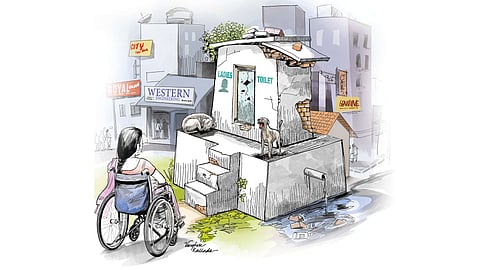

CHENNAI: While finding a moderately clean public toilet is rare in the city, it’s almost impossible for Persons With Disability (PwDs) to access them. Though crores have been spent by the Union and State governments on the basic amenity – public toilets, most of them are not inclusive.
This prevents the disabled from living an independent life, earn a livelihood, commute/travel for work and leisure, and other normal routines that the world is used to.
Too high, too narrow
Ranjana is a wheelchair user with paraplegia (paralysed from waist-down). Travelling long distance is a herculean task for her as most public toilets are inaccessible.
“Even for washing hands, I cannot use the water taps because they’re usually placed at a height I cannot reach. There’s absolutely no provision for handwashing that’s built keeping the needs of disabled in mind,” laments Ranjana, and adds that she’s considers herself lucky if she finds a half-decent toilet.
Most public toilets have no ramps. If they do, the ramp is too steep or small to accommodate a wheelchair. “More than the embarrassment, these toilets are also unhygienic and unclean. Can you imagine how I feel when I’ve to get down from the wheelchair and crawl to the bathroom? We appreciate and welcome all the schemes that the government authorities launch for the disabled but basic inclusiveness would be better,” she adds.
There are standards and guidelines while constructing ramps for the disabled. “Ramps must be of a certain height and width but such rules are never followed in most of public places, especially public toilets. The objective of a ramp is to enable a disabled person to access places on their own. But the way they’re constructed even in government buildings shows apathy towards the disabled,” rues S Namburajan, vice-president, Tamil Nadu Association for the Rights of all types of Differently Abled & Caregivers. “For those who are visually impaired, it’s even worse. The Braille signs and audio messaging are required at all points because not everyone is even aware of Braille, considering the people from rural areas.”
Not just ramps & railings
Disability rights activist Vaishnavi Jayakumar concurs, and adds that the infrastructure requirements for disabled persons do not end with ramps and railings. “The practicality of access to public toilets requires more basic facilities that need to be included in the planning stage itself, especially when tenders are being announced. This prevents corrections and modifications at a later stage, as they’re time-consuming and add to the cost,” she explains.
For instance, while building a public toilet, contractors must remember that some people might not be able to transfer themselves on the toilet from one side. So, the space has to be allocated on either side.
“There is not enough space for wheelchair users to enter even if ramps are available in certain public toilets. The height of the sink and taps are too high for them to reach. Adequate space should be given for them to move around. Regular toilets can be tweaked a bit and made accessible for those with disabilities,” points out Vaishnavi.
Even in star hotels…
Disability Rights Alliance (DRA) member Smitha Sadasivan says that inaccessible toilets are not just a commonality in the public milieu but even in star hotels too.
“Even the doors are very heavy. It’s not possible for wheelchair users and those on crutches to push them and get inside,” she rues. “Even for government events in big hotels, we struggle to find a proper washroom.”
Smitha points to the feasibility of sliding doors and accessories for people with disabilities. “Round taps need to be avoided because they cannot be used if your hands don’t have enough mobility. That’s why lever operated taps are a better option,” she elaborates. “For able-bodied people, these are irrelevant. But it’s makes a huge difference for the disabled, especially when there are a lot of signages and signs.”
Unhygienic, unclean
Activists and several people from the disabled community have stressed upon the need for government to create more awareness about cleanliness and hygiene practices among the public.
“People with immunocompromised conditions need to use the washroom frequently and are also at a higher risk of infection,” points out Smitha. “There are hundreds of cases of disabled men and women crawling on the floor of public toilets to access them. We need the basic dignity of clean places.”
The same applies to persons with visual impairments who have to touch surfaces while using toilets. “This is why the public needs to be made aware of hygiene practices and the encouragement to maintain cleanliness. The staff appointed to clean these toilets should be trained accordingly,” she avers.
Recently, the Greater Chennai Corporation announced that 366 public toilets will be constructed in the city within the next few months.
Would they be inclusive and follow all the guidelines necessary for the disabled to access them?
Visit news.dtnext.in to explore our interactive epaper!
Download the DT Next app for more exciting features!
Click here for iOS
Click here for Android